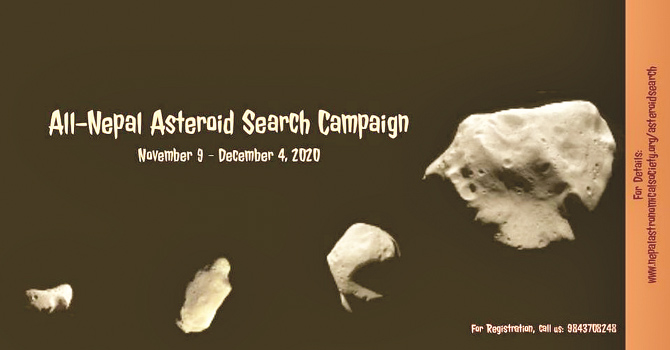Nepali amateur astronomers try to carve their space in history

By Shaurya Kshatri
Kathmandu, Nov. 8: The prospect of discovering a celestial object like an asteroid is sure enough to ignite wonder among astronomy enthusiasts, including young school-going children.
Over the past four years, several amateur astronomers and students from across Nepal have had a unique opportunity to survey the sky, interpret real-time telescopic images, and even discover asteroids. In collaboration with the International Astronomical Search Collaboration (IASC), the Nepal Astronomical Society (NASO) offers students from Nepal a chance to add to NASA's database of asteroids hurtling in space.
The overall purpose of the initiative, a large-scale worldwide effort under NASA, is to encourage students and citizen scientists to identify and document asteroids in the earth's environment to assess their threat to the planet and study them.
"In a way, young minds are given the opportunity of saving the earth," says Suresh Bhattarai, Astrophysicist and Chairman of NASO. Since 2016, Bhattarai and NASO have been actively encouraging Nepali youngsters to participate in the global campaign.
The campaign is hosted every month of the year. Before each one gets underway, the city-based organization holds a training for prospective participants where they teach students to work with high-quality astronomical data.
For the last campaign of the year, which is scheduled to begin on November 9 until December 3, 15 teams of 3 to 5 participants each from across the country will be selected.
Since its inception, the campaign has been increasingly effective where more and more student participants are making discernible progress. Just last year, 12-year-old Dhruv Vyas Joshi, from Kathmandu, while participating in the July edition of the campaign, became the youngest asteroid discoverer from Nepal after finding the asteroid named '2019 JP60' while studying in Grade 7.
"It is important to point out that asteroid discoveries have either preliminary or provisional status," adds Bhattarai. Preliminary discovery is the first observation of an unknown asteroid. "If you find an asteroid and it is observed a second time within the next 7-10 days then the discovery is changed to provisional status by the Minor Planet Centre (MPC)," further explains Bhattarai. So far, Nepal has two provisional discoveries to its name, including young Dhruv's find.
Apart from this, over 1,000 preliminary discoveries have been reported by amateur Nepali students. Sajan Acharya, one of the campaign's 2020 July edition participants, reported eight preliminary finds. "Sitting in front of your laptop and hunting for extra-terrestrial object has really given wings to my passion for space," purports Acharya, who is currently contemplating pursuing a Bachelor's Degree in Mechanical Engineering from the United States. Inquisitive students like Acharya are also taught skills required for sky mapping surveying but, most importantly, and at the end of the programme, are awarded a certificate of appreciation from NASA.
Expressing his gratitude towards the programme Sarbagya Gho Shrestha, class 12 (science), SOS HGS Sanothimi, Bhaktapur, said, "I would like to thank NASO Team for providing us with the opportunity to learn and discover near earth objects. (My) experience throughout the campaign was really fruitful where I got to learn about True and False signatures, identify and name the asteroids with the desktop application Astrometrica."
The feeling of discovering an object is "life-changing," according to Bhattarai, one of Nepal's first asteroid hunters. Perhaps this life-changing feeling is what students want to experience, each hoping to carve for themselves a little space in history.
Recent News

Do not make expressions casting dout on election: EC
14 Apr, 2022
CM Bhatta says may New Year 2079 BS inspire positive thinking
14 Apr, 2022
Three new cases, 44 recoveries in 24 hours
14 Apr, 2022
689 climbers of 84 teams so far acquire permits for climbing various peaks this spring season
14 Apr, 2022
How the rising cost of living crisis is impacting Nepal
14 Apr, 2022
US military confirms an interstellar meteor collided with Earth
14 Apr, 2022
Valneva Covid vaccine approved for use in UK
14 Apr, 2022
Chair Prachanda highlights need of unity among Maoist, Communist forces
14 Apr, 2022
Ranbir Kapoor and Alia Bhatt: Bollywood toasts star couple on wedding
14 Apr, 2022
President Bhandari confers decorations (Photo Feature)
14 Apr, 2022











